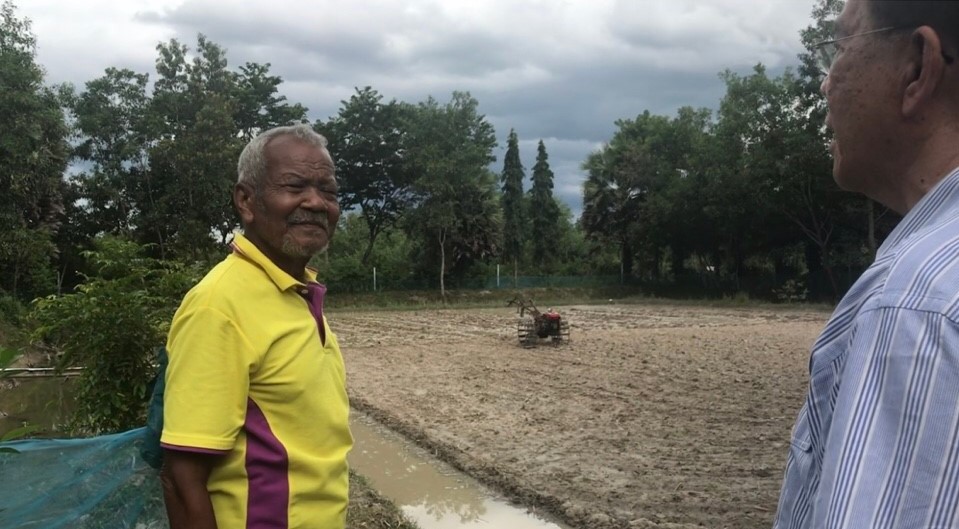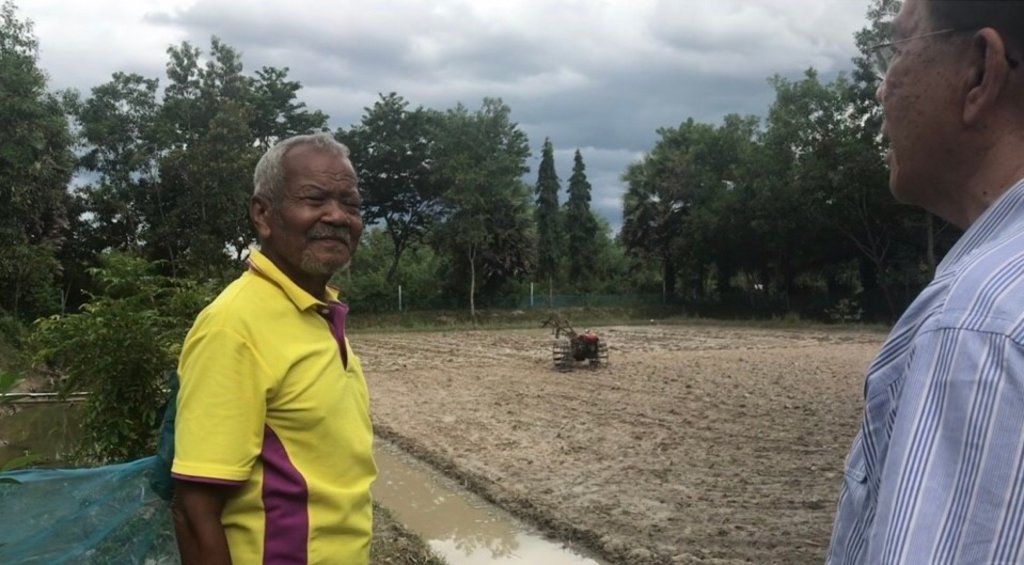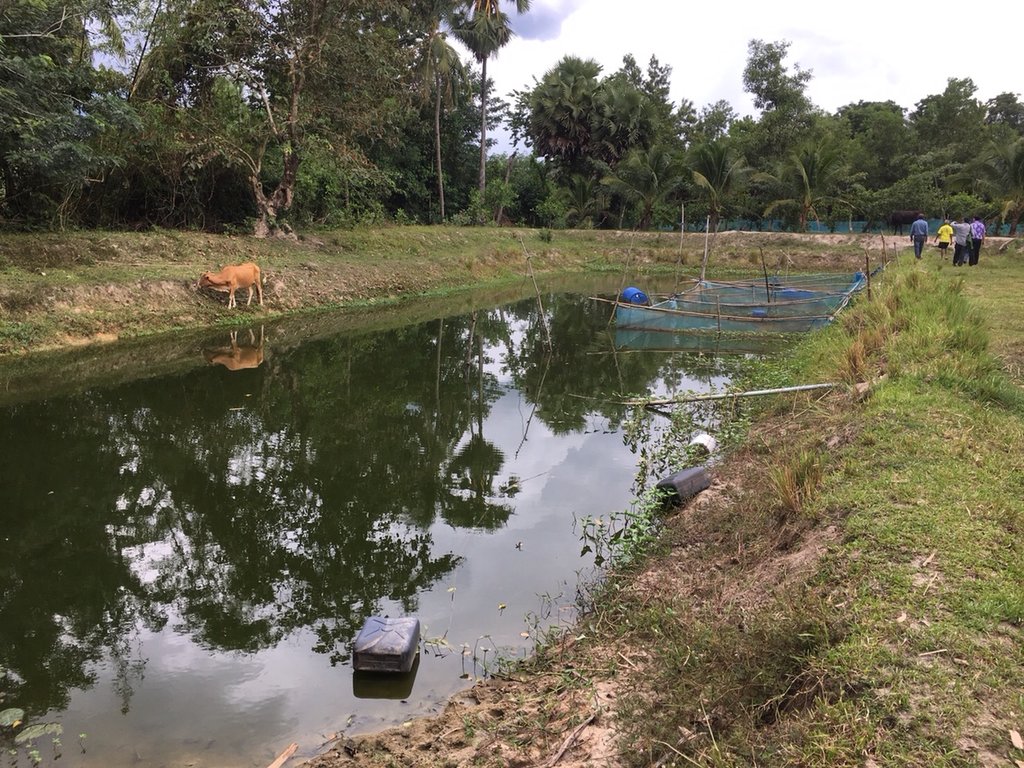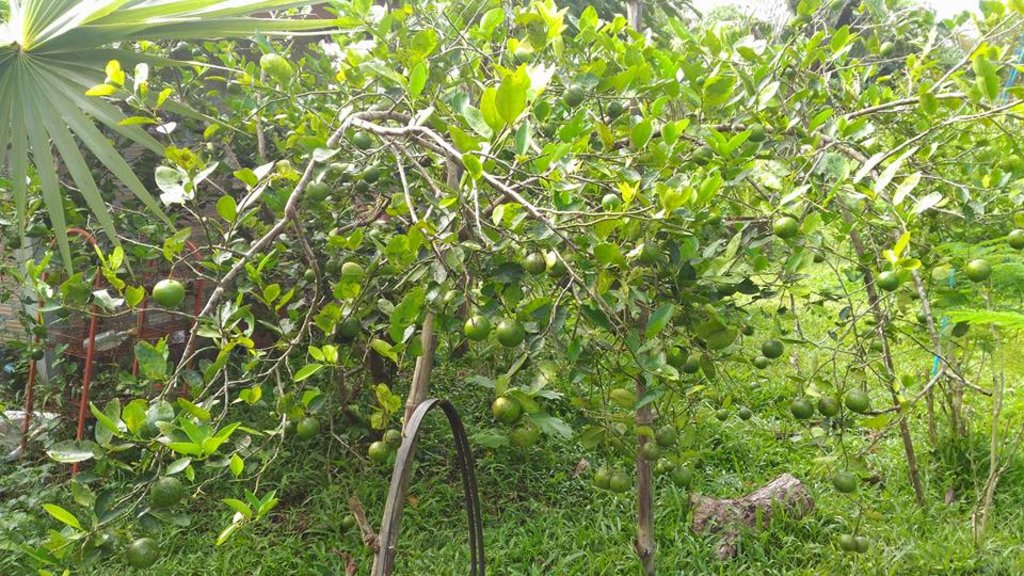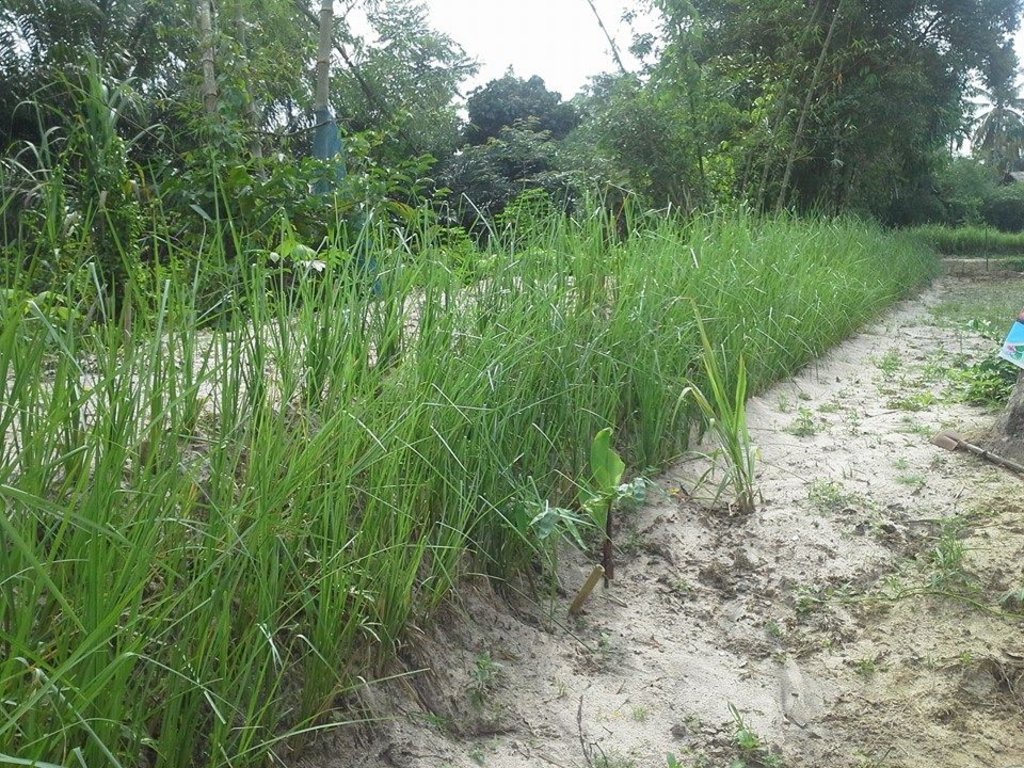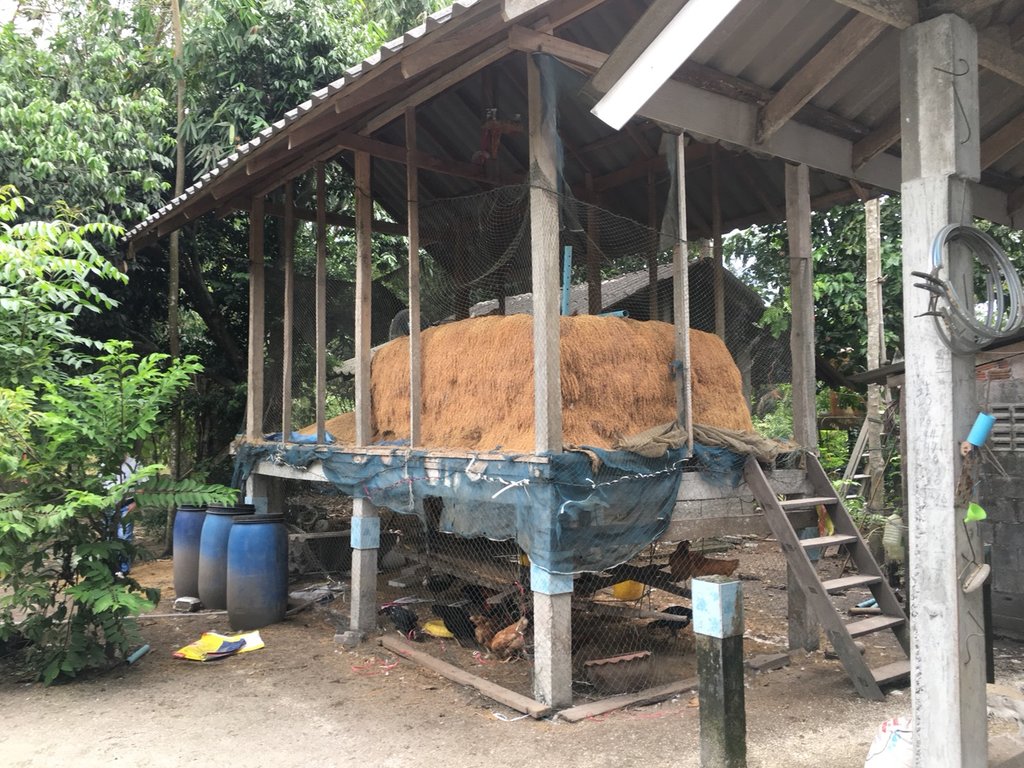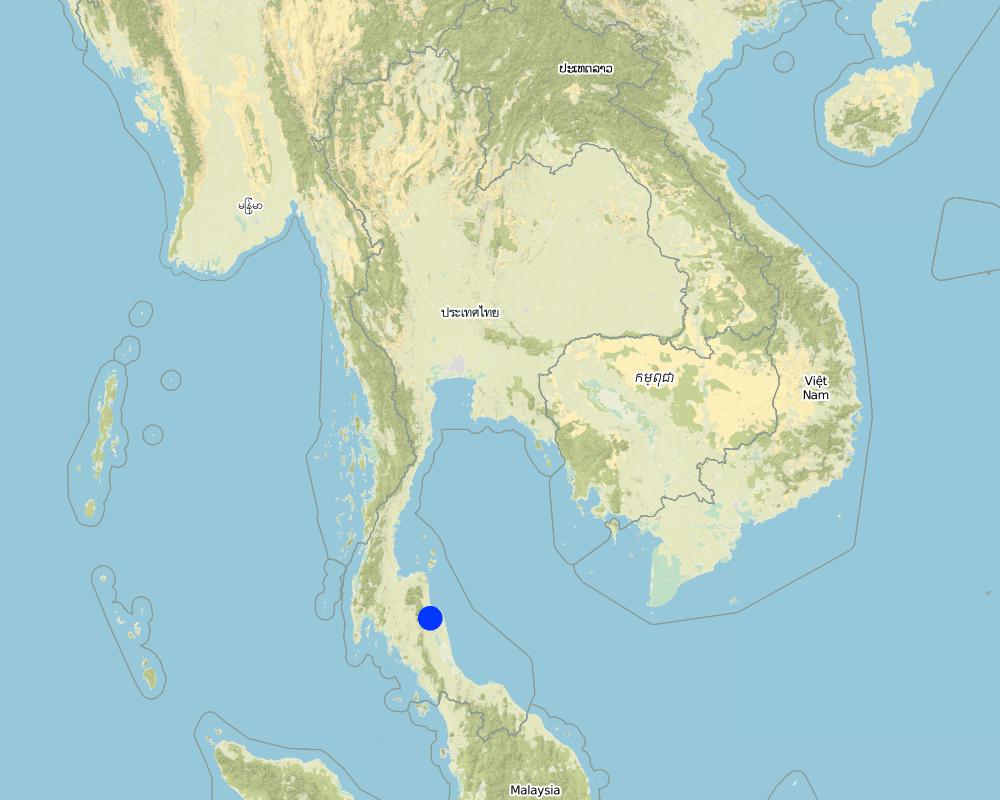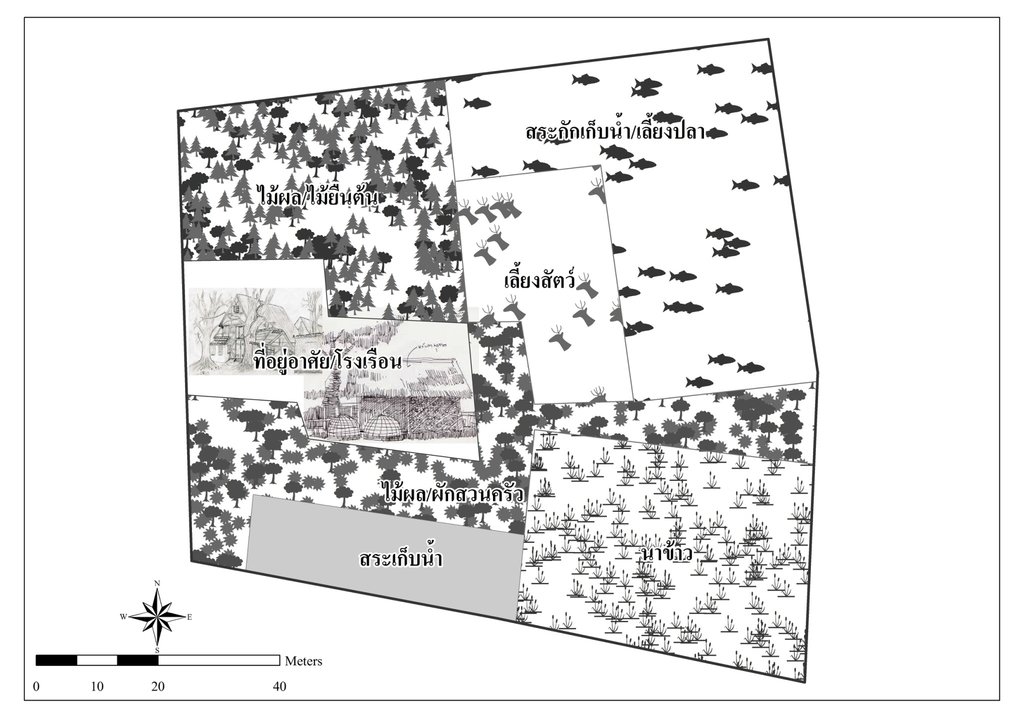The new theory of agriculture for mixed farming system [Thaïlande]
- Création :
- Mise à jour :
- Compilateur : Prapa Taranet
- Rédacteur : –
- Examinateur : Rima Mekdaschi Studer
The royal new theory of agriculture
technologies_4146 - Thaïlande
Voir les sections
Développer tout Réduire tout1. Informations générales
1.2 Coordonnées des personnes-ressources et des institutions impliquées dans l'évaluation et la documentation de la Technologie
Personne(s)-ressource(s) clé(s)
exploitant des terres:
Singhophon Chaung
Thaïlande
Nom du projet qui a facilité la documentation/ l'évaluation de la Technologie (si pertinent)
Decision Support for Mainstreaming and Scaling out Sustainable Land Management (GEF-FAO / DS-SLM)Nom du ou des institutions qui ont facilité la documentation/ l'évaluation de la Technologie (si pertinent)
Land Development Department (Land Development Department) - Thaïlande1.3 Conditions relatives à l'utilisation par WOCAT des données documentées
Le compilateur et la(les) personne(s) ressource(s) acceptent les conditions relatives à l'utilisation par WOCAT des données documentées:
Oui
1.4 Déclaration sur la durabilité de la Technologie décrite
Est-ce que la Technologie décrite ici pose problème par rapport à la dégradation des terres, de telle sorte qu'elle ne peut pas être déclarée comme étant une technologie de gestion durable des terres?
Non
2. Description de la Technologie de GDT
2.1 Courte description de la Technologie
Définition de la Technologie:
Allocating and managing small-scale farm areas to make it be able to use for agricultural production with the highest efficiency
2.2 Description détaillée de la Technologie
Description:
The new theory of agriculture is the application of mixed farming systems to poor farmers on small land holdings in Chang Sai sub-district, Phra Phrom district, Nakhon Si Thammarat province, Thailand. The most important concept of new theory farming is an efficient allocation of land to serve the different needs of farm households, including paddy fields, farm ponds for water and fishes, and cash crops, fruit trees, and trees for farm income, plus a residential area. It has a goal to solve the problem of shortage of land and water resources, which is a very important problem in Thailand, for making a living of smallholder farmers. Apart from the fact that the size of the area and water resources are the limit factors for farmers in this area, the land is also degraded causing by both natural and human activities. The area is classified as sand dunes with low to very low soil fertility where farmers mostly grew same plant species in the whole area during the rainy season of every year. This results in high risks in regard to a fluctuation of the amount of production and insufficient food crop production for household consumption. Therefore, land allocation for agriculture under the concept of the new theory agriculture can be the appropriate measure in making use of resources of small-scale areas for optimal benefits and increase incomes for a household. Nowadays, farmers in the adjacent area realized the benefits obtained from allocating the area, they formed a group of farmers in order to set up management, improve the use of their small-scale areas for optimal benefits.
The new agricultural theory was initiated by His Majesty the Late King Bhumibol Adulyadej of Thailand to provide help for farmers who had small-scale areas for agricultural purposes. For the land allocation, the land is divided into 4 parts. Part 1 is designated for a pond to store rainwater during the rainy season and to supply water to grow crops in the dry season as well as for raising aquatic animals (fishes, field crabs) and plants (such as morning glory, water mimosa, etc.). Part 2 is set aside for rice cultivation during the rainy season as a daily staple in households throughout the year sufficiently, which cut down on expenses and allow the farmers to be self-reliant. Part 3 is used for growing fruit and bearing trees, perennials, vegetables, field crops for daily consumption. If any surplus from consumption, it can be sold. Part 4 is used for dwelling, animal husbandry, roads and other structures (barn, straw, pile of compost, houses, mushroom nurseries, stalls, flowering-plants, ornamental plants, home-grown vegetables of backyard gardens). In any case, the proportion of the area in each section can be adjusted for either increase or decrease depending on the suitability of area conditions of each location and the necessity of farmers who make use of the area, but it is usually 30:30:30:10.
2.3 Photos de la Technologie
2.5 Pays/ région/ lieux où la Technologie a été appliquée et qui sont couverts par cette évaluation
Pays:
Thaïlande
Région/ Etat/ Province:
Nakhon Si Thammarat province
Autres spécifications du lieu:
Chang Sai sub-district, Phra Phrom district
Spécifiez la diffusion de la Technologie:
- appliquée en des points spécifiques ou concentrée sur une petite surface
Est-ce que les sites dans lesquels la Technologie est appliquée sont situés dans des zones protégées en permanence?
Non
Map
×2.6 Date de mise en œuvre de la Technologie
Indiquez l'année de mise en œuvre:
2010
2.7 Introduction de la Technologie
Spécifiez comment la Technologie a été introduite: :
- par le biais de projets/ d'interventions extérieures
Commentaires (type de projet, etc.) :
This technology was initiated by His Majesty the Late King Bhumibol Adulyadej of Thailand and disseminated to farmers by several departments under Ministry of Agriculture and Cooperatives
3. Classification de la Technologie de GDT
3.1 Principal(aux) objectif(s) de la Technologie
- améliorer la production
- réduire, prévenir, restaurer les terres dégradées
- créer un impact économique positif
3.2 Type(s) actuel(s) d'utilisation des terres, là où la Technologie est appliquée
Les divers types d'utilisation des terres au sein du même unité de terrain: :
Non

Terres cultivées

Autre
Précisez:
Mixed farming system
Remarques:
cropland mixed with aquatic animals
Commentaires:
Crops include rice, vegetable, limes, tropical fruits, and trees, while aquatic animals include a variety of fishes, field crabs.
3.3 Est-ce que l’utilisation des terres a changé en raison de la mise en œuvre de la Technologie ?
Est-ce que l’utilisation des terres a changé en raison de la mise en œuvre de la Technologie ?
- Oui (Veuillez remplir les questions ci-après au regard de l’utilisation des terres avant la mise en œuvre de la Technologie)
Les divers types d'utilisation des terres au sein du même unité de terrain: :
Non

Terres cultivées
- Cultures annuelles
Cultures annuelles - Précisez les cultures:
- céréales - riz (de terres humides)
Est-ce que les cultures intercalaires sont pratiquées?
Non
Est-ce que la rotation des cultures est appliquée?
Non
3.4 Approvisionnement en eau
Approvisionnement en eau des terres sur lesquelles est appliquée la Technologie:
- pluvial
3.5 Groupe de GDT auquel appartient la Technologie
- récupération/ collecte de l'eau
- Jardins/ potagers familiaux
3.6 Mesures de GDT constituant la Technologie

pratiques agronomiques
- A1: Couverture végétale/ du sol
- A2: Matière organique/ fertilité du sol

pratiques végétales
- V2: Herbes et plantes herbacées pérennes

structures physiques
- S5: Barrages/retenues, micro-bassins, étangs

modes de gestion
- M2: Changement du niveau de gestion / d'intensification

autres mesures
Précisez:
Introduction of aquatic animal
3.7 Principaux types de dégradation des terres traités par la Technologie

dégradation chimique des sols
- Cn: baisse de la fertilité des sols et réduction du niveau de matière organique (non causée par l’érosion)

dégradation hydrique
- Ha: aridification
3.8 Prévention, réduction de la dégradation ou réhabilitation des terres dégradées
Spécifiez l'objectif de la Technologie au regard de la dégradation des terres:
- réduire la dégradation des terres
4. Spécifications techniques, activités, intrants et coûts de mise en œuvre
4.1 Dessin technique de la Technologie
Spécifications techniques (associées au dessin technique):
Land allocation according to new theory of agriculture in the area with the size of 5.3 rai of informants by dividing the land into 4 parts, first part is the ponds accounting for 1.5 rai (about 28% of the total area), second part is paddy field accounting for 1 rai (about 19% of the total area), third part is for growing fruit-bearing trees, home-grown vegetables, perennials accounting for 1.3 rai (about 25% of the total area) and last is for building construction for dwelling, animal husbandry and other constructions accounting for 1.5 rai ( about 28% of the total area).
Auteur:
Prapa Taranet
Date:
20/09/2018
4.2 Informations générales sur le calcul des intrants et des coûts
Spécifiez la manière dont les coûts et les intrants ont été calculés:
- par superficie de la Technologie
Indiquez la taille et l'unité de surface:
5.3
Si vous utilisez une unité de superficie locale, indiquez le facteur de conversion vers un hectare (p.ex. 1 ha = 2.47 acres): 1 ha = :
6.5
autre/ monnaie nationale (précisez):
Baht
Indiquez le taux de change des USD en devise locale, le cas échéant (p.ex. 1 USD = 79.9 réal brésilien): 1 USD = :
33,0
Indiquez le coût salarial moyen de la main d'œuvre par jour:
300 Baht
4.3 Activités de mise en place/ d'établissement
| Activité | Calendrier des activités (saisonnier) | |
|---|---|---|
| 1. | Pond construction | dry season |
| 2. | Labours | rainy season |
| 3. | Seeds | rainy season |
| 4. | Seedling | rainy season |
| 5. | Aqautic animals (fishes and field crabs) | rainy season |
4.4 Coûts et intrants nécessaires à la mise en place
| Spécifiez les intrants | Unité | Quantité | Coûts par unité | Coût total par intrant | % des coût supporté par les exploitants des terres | |
|---|---|---|---|---|---|---|
| Main d'œuvre | Cultivation | days | 60,0 | 300,0 | 18000,0 | 100,0 |
| Equipements | Hiring tractors for pond construction | ponds | 3,0 | 16000,0 | 48000,0 | 70,0 |
| Matériel végétal | Seeds | Kilogram | 300,0 | 10,0 | 3000,0 | |
| Matériel végétal | Seedlings | Plants | 100,0 | 50,0 | 5000,0 | 80,0 |
| Engrais et biocides | Compost | Ton | 1,0 | 2500,0 | 2500,0 | 50,0 |
| Matériaux de construction | Roof tiles | each | 240,0 | 60,0 | 14400,0 | |
| Matériaux de construction | Cement | bags | 8,0 | 100,0 | 800,0 | |
| Matériaux de construction | Sand and rocks | ton | 1,0 | 1650,0 | 1650,0 | |
| Matériaux de construction | Pillars | each | 12,0 | 100,0 | 1200,0 | |
| Autre | Fishes and crabs | each | 2500,0 | 1,0 | 2500,0 | |
| Coût total de mise en place de la Technologie | 97050,0 | |||||
| Coût total de mise en place de la Technologie en dollars américains (USD) | 2940,91 | |||||
Si le coût n'est pas pris en charge à 100% par l'exploitant des terres, indiquez qui a financé le coût restant:
Government agencies
4.5 Activités d'entretien/ récurrentes
| Activité | Calendrier/ fréquence | |
|---|---|---|
| 1. | Labours | throughout the year |
| 2. | Seeds | rainy season |
| 3. | Seedlings | rainy season |
| 4. | Aquatic animal | 9 months |
4.6 Coûts et intrants nécessaires aux activités d'entretien/ récurrentes (par an)
| Spécifiez les intrants | Unité | Quantité | Coûts par unité | Coût total par intrant | % des coût supporté par les exploitants des terres | |
|---|---|---|---|---|---|---|
| Main d'œuvre | Cultivation | days | 260,0 | 300,0 | 78000,0 | 100,0 |
| Main d'œuvre | Cultivation | days | 260,0 | 300,0 | 78000,0 | 100,0 |
| Engrais et biocides | Compost | ton | 1,0 | 2500,0 | 2500,0 | 50,0 |
| Autre | Fishes and crabs | each | 5000,0 | 1,0 | 5000,0 | 30,0 |
| Autre | Feeding | month | 9,0 | 5000,0 | 45000,0 | 100,0 |
| Coût total d'entretien de la Technologie | 208500,0 | |||||
| Coût total d'entretien de la Technologie en dollars américains (USD) | 6318,18 | |||||
Si le coût n'est pas pris en charge à 100% par l'exploitant des terres, indiquez qui a financé le coût restant:
Government agencies support some inuts
4.7 Facteurs les plus importants affectant les coûts
Décrivez les facteurs les plus importants affectant les coûts :
Water - if there is a lack of water during the dry season, some agricultural activities may not be practiced. This leads to a reduction of agricultural cost; however, this also leads to a reduction of a household income during that period.
5. Environnement naturel et humain
5.1 Climat
Précipitations annuelles
- < 250 mm
- 251-500 mm
- 501-750 mm
- 751-1000 mm
- 1001-1500 mm
- 1501-2000 mm
- 2001-3000 mm
- 3001-4000 mm
- > 4000 mm
Spécifiez la pluviométrie moyenne annuelle (si connue), en mm:
274,00
Indiquez le nom de la station météorologique de référence considérée:
Nakhon Si Thammarat meteorological station
Zone agro-climatique
- subhumide
5.2 Topographie
Pentes moyennes:
- plat (0-2 %)
- faible (3-5%)
- modéré (6-10%)
- onduleux (11-15%)
- vallonné (16-30%)
- raide (31-60%)
- très raide (>60%)
Reliefs:
- plateaux/ plaines
- crêtes
- flancs/ pentes de montagne
- flancs/ pentes de colline
- piémonts/ glacis (bas de pente)
- fonds de vallée/bas-fonds
Zones altitudinales:
- 0-100 m
- 101-500 m
- 501-1000 m
- 1001-1500 m
- 1501-2000 m
- 2001-2500 m
- 2501-3000 m
- 3001-4000 m
- > 4000 m
Indiquez si la Technologie est spécifiquement appliquée dans des:
- non pertinent
5.3 Sols
Profondeur moyenne du sol:
- très superficiel (0-20 cm)
- superficiel (21-50 cm)
- modérément profond (51-80 cm)
- profond (81-120 cm)
- très profond (>120 cm)
Texture du sol (de la couche arable):
- grossier/ léger (sablonneux)
Texture du sol (> 20 cm sous la surface):
- grossier/ léger (sablonneux)
Matière organique de la couche arable:
- faible (<1%)
Si disponible, joignez une description complète du sol ou précisez les informations disponibles, par ex., type de sol, pH/ acidité du sol, capacité d'échange cationique, azote, salinité, etc.
The soil in this area is sandy soil, classified into Coated, isohyperthermic and Typic Quartzipsamments. The parent material is beach ridge or sand dune. The area condition is quite flat up to little undulating with the slope of 1.5%. The soil is very deep and well drained. Water permeability is fast but runoff on the soil surface occurs slowly. The soil reaction is very acidic to a little acidic (pH 5.0 - 6.5) throughout the soil profile. The soil fertility is low. Land use limitation is low fertility and a shortage of water.
5.4 Disponibilité et qualité de l'eau
Profondeur estimée de l’eau dans le sol:
5-50 m
Disponibilité de l’eau de surface:
moyenne
Qualité de l’eau (non traitée):
uniquement pour usage agricole (irrigation)
La qualité de l'eau fait référence à:
eaux de surface
La salinité de l'eau est-elle un problème? :
Non
La zone est-elle inondée?
Non
5.5 Biodiversité
Diversité des espèces:
- moyenne
Diversité des habitats:
- moyenne
5.6 Caractéristiques des exploitants des terres appliquant la Technologie
Sédentaire ou nomade:
- Sédentaire
Orientation du système de production:
- exploitation mixte (de subsistance/ commerciale)
Revenus hors exploitation:
- moins de 10% de tous les revenus
Niveau relatif de richesse:
- moyen
Individus ou groupes:
- individu/ ménage
Niveau de mécanisation:
- travail manuel
Genre:
- hommes
Age des exploitants des terres:
- personnes âgées
5.7 Superficie moyenne des terres utilisées par les exploitants des terres appliquant la Technologie
- < 0,5 ha
- 0,5-1 ha
- 1-2 ha
- 2-5 ha
- 5-15 ha
- 15-50 ha
- 50-100 ha
- 100-500 ha
- 500-1 000 ha
- 1 000-10 000 ha
- > 10 000 ha
Cette superficie est-elle considérée comme de petite, moyenne ou grande dimension (en se référant au contexte local)?
- petite dimension
5.8 Propriété foncière, droits d’utilisation des terres et de l'eau
Propriété foncière:
- individu, avec titre de propriété
Droits d’utilisation des terres:
- individuel
Droits d’utilisation de l’eau:
- individuel
5.9 Accès aux services et aux infrastructures
santé:
- pauvre
- modéré
- bonne
éducation:
- pauvre
- modéré
- bonne
assistance technique:
- pauvre
- modéré
- bonne
emploi (par ex. hors exploitation):
- pauvre
- modéré
- bonne
marchés:
- pauvre
- modéré
- bonne
énergie:
- pauvre
- modéré
- bonne
routes et transports:
- pauvre
- modéré
- bonne
eau potable et assainissement:
- pauvre
- modéré
- bonne
services financiers:
- pauvre
- modéré
- bonne
6. Impacts et conclusions
6.1 Impacts sur site que la Technologie a montrés
Impacts socio-économiques
Production
production agricole
Quantité avant la GDT:
100
Quantité après la GDT:
500
Commentaires/ spécifiez:
Considering from rice production in 1 rai
qualité des cultures
risque d'échec de la production
Commentaires/ spécifiez:
As farmer allocates the land to different types of crop, they can evaluate the suitable types of crops for the markets and climatic conditions
Disponibilité et qualité de l'eau
disponibilité de l'eau pour l'élevage
disponibilité de l'eau d'irrigation
Commentaires/ spécifiez:
Rainwater can be collected in the ponds and this could supply to cultivation during the dry season
Revenus et coûts
dépenses pour les intrants agricoles
revenus agricoles
diversité des sources de revenus
charge de travail
Impacts socioculturels
connaissances sur la GDT/ dégradation des terres
Commentaires/ spécifiez:
The knowledge about SLM comes through the support of the government agencies
Impacts écologiques
Sols
humidité du sol
couverture du sol
matière organique du sol/ au dessous du sol C
Commentaires/ spécifiez:
Application of compost in the farm leads to an increase in soil organic matter
Biodiversité: végétale, animale
espèces bénéfiques
Commentaires/ spécifiez:
Earthworms, Birds, Bees, Cicada, and Varanus.
6.2 Impacts hors site que la Technologie a montrés
pollution des rivières/ nappes phréatiques
Commentaires/ spécifiez:
Agrichemical products did not apply to the farmland, resulting in less soil contamination to environment
6.3 Exposition et sensibilité de la Technologie aux changements progressifs et aux évènements extrêmes/catastrophes liés au climat (telles que perçues par les exploitants des terres)
Changements climatiques progressifs
Changements climatiques progressifs
| Saison | Augmentation ou diminution | Comment la Technologie fait-elle face à cela? | |
|---|---|---|---|
| températures saisonnières | été | augmente | modérément |
6.4 Analyse coûts-bénéfices
Quels sont les bénéfices comparativement aux coûts de mise en place (du point de vue des exploitants des terres)?
Rentabilité à court terme:
neutre / équilibrée
Rentabilité à long terme:
positive
Quels sont les bénéfices comparativement aux coûts d'entretien récurrents (du point de vue des exploitants des terres)?
Rentabilité à court terme:
positive
Rentabilité à long terme:
positive
6.5 Adoption de la Technologie
- 11-50%
Si disponible, quantifiez (nombre de ménages et/ou superficie couverte):
Members in the community (about 50-60 households in the community) and parts of the outside community nearby show interest in this technology because they see that it can increase household incomes and start to implement it in their own areas. However, allocation of the land differs according to the area conditions and the needs of the owners themselves.
De tous ceux qui ont adopté la Technologie, combien d'entre eux l'ont fait spontanément, à savoir sans recevoir aucune incitation matérielle, ou aucune rémunération? :
- 0-10%
Commentaires:
The government provides some inputs for farmers who want to apply this technology to their farmland such as fishes and rice seeds. Then most farmers get some support before they start the activity on the farm.
6.6 Adaptation
La Technologie a-t-elle été récemment modifiée pour s'adapter à l'évolution des conditions?
Oui
Si oui, indiquez à quel changement la Technologie s'est adaptée:
- évolution des marchés
Spécifiez l'adaptation de la Technologie (conception, matériaux/ espèces, etc.):
Since organic markets get bigger in the areas, then some farmers produce their products without using agrichemical products. This allows farmers to improve the price for their products.
6.7 Points forts/ avantages/ possibilités de la Technologie
| Points forts/ avantages/ possibilités du point de vue de l'exploitant des terres |
|---|
| Water can be available even in the dry season since this technology includes the farm pond construction for rainwater storage. |
| Farmers should be able to grow enough rice for the whole year’s consumption. |
| Production planning can be done for the household consumption and supply to the market. |
| Points forts/ avantages/ possibilités du point de vue du compilateur ou d'une autre personne ressource clé |
|---|
| Allocation of the land into 4 parts according to the new theory of agriculture is considered an appropriate option for smallholder farmers who are having small farmland and water shortage. This is due to they can plan what crops, and when, to grow for each growing season based on climatic condition and market. Importantly, farmers learn how to plan the production that will be distributed to the market and for making a living. |
6.8 Faiblesses/ inconvénients/ risques de la Technologie et moyens de les surmonter
| Faiblesses/ inconvénients/ risques du point de vue de l’exploitant des terres | Comment peuvent-ils être surmontés? |
|---|---|
| A lack of household labor results in some farmers adopted only part of technology where the efficiency of this technology may be lower than the adoption of full management. | Mose farmers hire labor or mechanical equipment to help them farming. although this increases the farming cost, it helps farmers to get their work done in time. |
| The cost of investment is rather high, especially for digging the pond. | Farmers ask the support from the government. While some farmers receive 80% help from the government, foundations, and the private sector for digging the ponds, others receive less support from the government. |
| Farmers have limited land for farming, to allocate the land to usual allocation as recommendation may not be suitable. | Farmers changed or improved the allocation ratio by themselves based on the land conditions, climatic condition, and the environment. For example, some farmers who have enough water sources in their areas, the size of the pond can be reduced to make room for other uses. |
| Faiblesses/ inconvénients/ risques du point de vue du compilateur ou d'une autre personne ressource clé | Comment peuvent-ils être surmontés? |
|---|---|
| Due to the fact that managing the area with many activities may require more time to take action than monoculture farming, which cannot interest some farmers to practice. Furthermore, it may take time to make it worth the paid expenses due to complexity, little understanding, insufficient labor force, and more hiring may require. | The government needs to take action in the areas to provide more knowledge on this technology and find the solution to the problems. |
7. Références et liens
7.1 Méthodes/ sources d'information
- visites de terrain, enquêtes sur le terrain
1
- interviews/entretiens avec les exploitants des terres
1
- interviews/ entretiens avec les spécialistes/ experts de GDT
1
Quand les données ont-elles été compilées (sur le terrain)?
20/09/2018
7.2 Références des publications disponibles
Titre, auteur, année, ISBN:
New Theory of Agriculture, 2011, Office of the Royal Development Projects Board.
Disponible à partir d'où? Coût?
http://www.rdpb.go.th/UploadNew/Documents/%E0%B8%97%E0%B8%A4%E0%B8%A9%E0%B8%8E%E0%B8%B5%E0%B9%83%E0%B8%AB%E0%B8%A1%E0%B9%88.pdf
Titre, auteur, année, ISBN:
Implementation manual for new theory of agriculture, 2015, Ministry of Agriculture and Cooperatives.
Disponible à partir d'où? Coût?
http://www3.oae.go.th/rdpcc/images/filesdownload/SUFFICIENCY/9.9.pdf
7.3 Liens vers les informations pertinentes en ligne
Titre/ description:
Sufficiency Economy & New Theory
URL:
http://www.chaipat.or.th/eng/concepts-theories/sufficiency-economy-new-theory.html
7.4 Observations d'ordre général
The long-term impact on household income might change or improve if they practice this technology longer period than 8 years.
Liens et modules
Développer tout Réduire toutLiens
Aucun lien
Modules
Aucun module trouvé


